| |
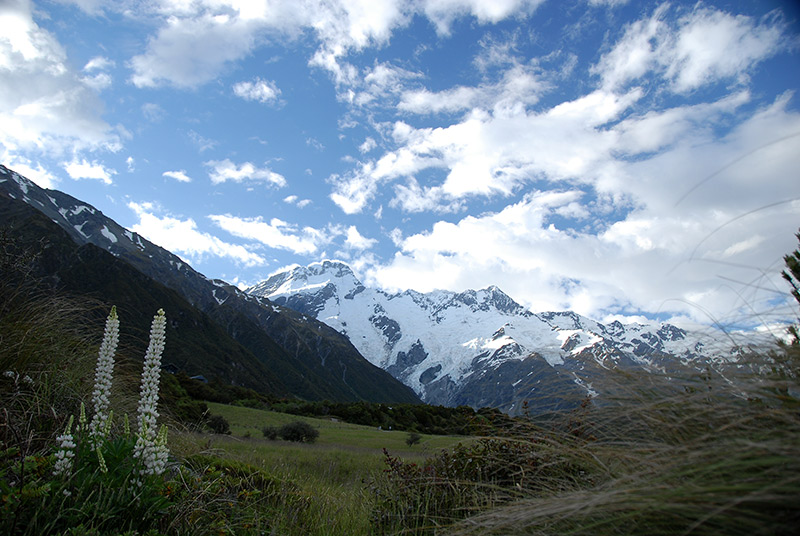 |
|
| |
New Zealand’s Alps with summer snow |
|
| |
|
|
| |
For the second time in a year I was enjoying the longest day of the year. But just like the June 21 longest day spent traipsing around in my home state of Oregon, the December 21 version in New Zealand zipped by way too quickly.
While my friends in the U.S. were awakening to the northern hemisphere's shortest day of the year, I was off to a running—OK, jogging—start to the southern hemisphere's longest day, one with more than 16 hours of sun light.
It was a pathetically slow, leg-loosening trot. Still weary from more than 36 hours of driving, flying and hanging out at airports, my head felt like caramelized tofu and my legs like warmed jello. |
|
| |
|
|
| |
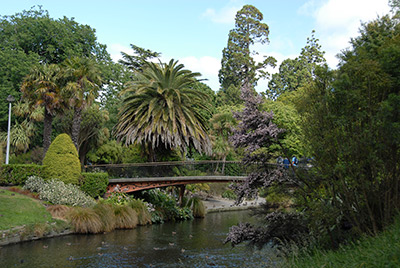 |
|
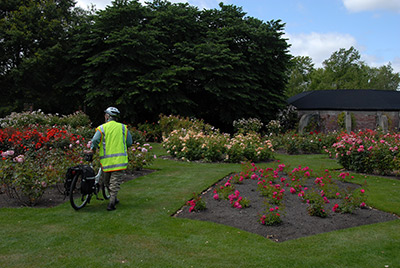 |
|
| |
Christchurch bridge along the Avon River |
|
Walking through a rose garden |
|
| |
|
|
|
|
| |
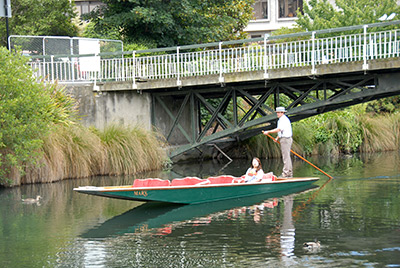 |
|
| |
Gondola ride along the Avon |
|
| |
|
|
| |
A day earlier, after an evening arrival in Christchurch, a fitful sleep-deprived night had been followed by a morning-guided bicycle ride through the city, one devastated by a series of building-tumbling earthquakes. A third of the previously beautiful city, including large blocks of its downtown area, was destroyed by a series of February 2011 quakes. On December 23, only days after our tour, more physical and emotional damage done by two significant shakes.
The afternoon following our tour, my friends and I made the drive to Glentanner Station, a 45,000-acre sheep station that also includes an RV park, hostel, restaurant and adventure center south of Mount Cook National Park. |
|
| |
|
|
| |
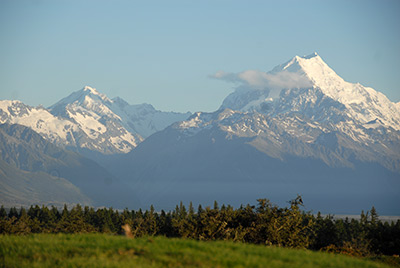 |
|
| |
Mount Cook, from our Glentanner cabin |
|
| |
|
|
| |
Despite my slumbered senses, they quickly awakened as the road I ran along rounded a curve, revealing eye-popping views of Mount Cook, its 12,316-foot snow-capped peak—New Zealand's tallest—abruptly towering more than 10,000 vertical feet above the valley floor. A picket line of ragged, jagged peaks stood like sentinels to the west, seemingly guarding the approach to Cook. To the east, Lake Pukaki, nine and a half miles long and five miles wide, shimmered brilliantly in the cloudless morning.
Pukaki and other neighboring lakes gain their milky turquoise colors from rock flour, the fine particles of rock ground out of the mountains slow moving glaciers. As the rock flour winds through braided rivers into Pukaki and other lakes, the fine particles are suspended in the water, creating the ethereal colors. |
|
| |
|
|
| |
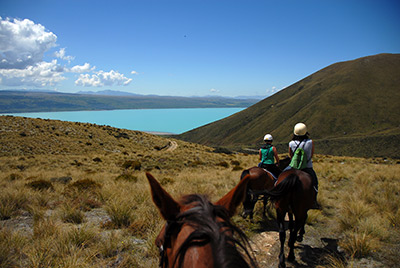 |
|
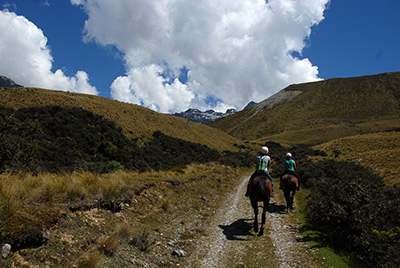 |
|
| |
Lake Pukaki from horseback |
|
Riding the trail |
|
| |
|
|
|
|
| |
A few hours later we viewed Lake Pukaki from a higher vantage. Our mid-morning horseback ride from the Glentanner stables wound steeply up a four wheel drive road/trail in a valley carved by one of the streams that feeds into Pukaki. Like the others, I sat in the saddle, literally along for the ride. The horses moved slowly, but they were also the ones doing all the work. Work it was as we went up, up and up, each bend revealing more expansive views of the lake, valley Cook and its neighboring Alps peak. After more than an hour’s ride, we reached our turnaround point—an abandoned sheep camp. |
|
| |
|
|
| |
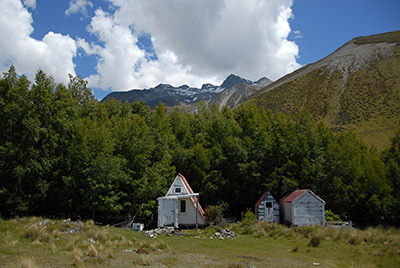 |
|
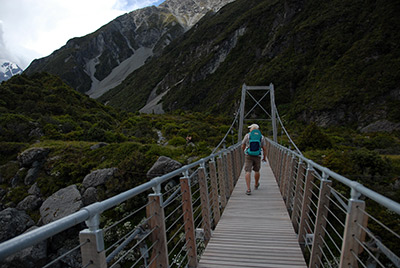 |
|
| |
Abandoned sheep camp |
|
Crossing the first Swing bridge |
|
| |
|
|
|
|
| |
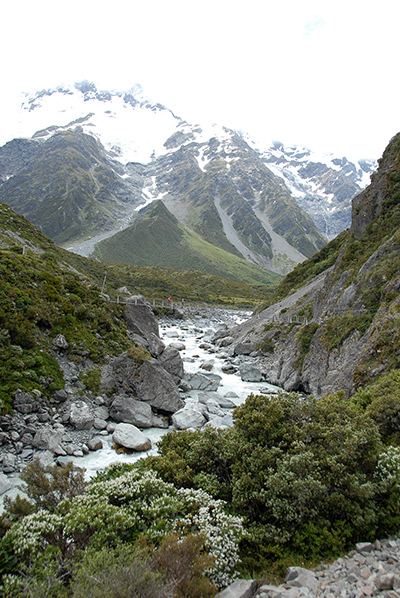 |
|
| |
Raging Hooker River |
|
| |
|
|
| |
And not too many hours later, in mid-afternoon, our trio joined a parade of others coming and going along the Hooker Valley Trail. From a trailhead near the Mount Cook Village, the trail meanders about three miles to and along the Hooker River, making a pair of river crossings on tipsy swing bridges and passing along glacial moraine walls. |
|
| |
|
|
| |
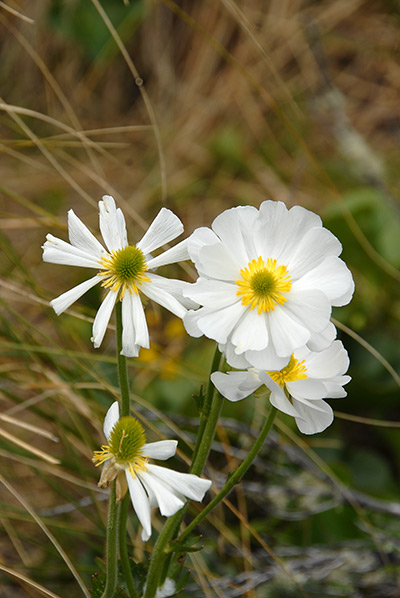 |
|
Near the Stocking Stream shelter, so named because 19th century walkers who stopped and soaked their feet here, I spotted my first Mount Cook lily, a snowy white flower with large glossy leaves. Although called a lily, the beautiful flower is actually the world's largest buttercup. Mount Cook lilies grow in clumps up to three feet tall and 14 inches wide, with convex cup-shaped flower heads that hold rainwater. I would find others that day and other days over my two-week visit, but the first generated a satisfying sense of awe and discovery. |
|
| |
My first Mount Cook lily |
|
|
|
| |
|
|
| |
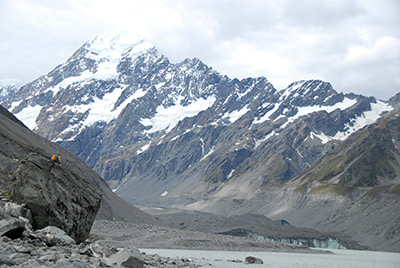 |
|
| |
Hooker Lake, the snout of the Hooker Glacier and, in the distance, the Cloud Piercer |
|
| |
|
|
| |
From the shelter, sections of the trail follow a boardwalk, ending at the lake created where the Hooker Glacier reaches its terminus. Small icebergs floated along the cream-textured lake. The scenery along the trail is dazzling, but the final third from the shelter to the glacier adds a gee-whiz element with in-your-face views of Mount Cook. To the Maoris, New Zealand's native people, Cook is known as Aorangi, which translates to a far more aptly descriptive name, Cloud Piercer. |
|
| |
|
|
| |
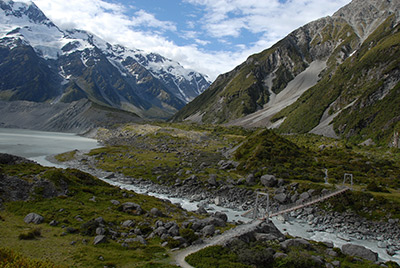 |
|
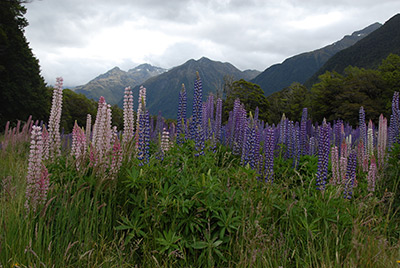 |
|
| |
The view from the overlook |
|
Russell lupines |
|
| |
|
|
|
|
| |
Cook-Aorangi was mostly shielded from view on the hike back to the trailhead, but the views still dazzled. From an overlook we peered down to the first swing bridge, the surging, rumbling whitewater river it crosses, and the glacial-cut V-shaped valley while passing fields to tall Russell lupines, plants introduced by New Zealand settlers in the 1930s that dominate roadsides and fields with soils low in nutrients.
That night, at Glentanner's well-stocked community kitchen, we cooked—and quickly devoured—a large pot of spaghetti flavored with tomato sauce, mushrooms, fresh garlic and red peppers. After dinner, I lounged in the community hall's sleep-inducing chairs underneath a sheep mural, listening to a mishmash of Kiwi and Australian accents and foreign languages while the others slipped into their sleeping bags. |
|
| |
|
|
| |
 |
|
| |
Glentanner sheep mural |
|
| |
|
|
| |
We had planned to cap our longest day gazing at the southern hemisphere’s night sky, eager to see new constellations. Those hopes were extinguished by tired eyes and a night sky that, even hours after sunset, refused to darken.
It was the year's longest day but, despite our longings, it proved way too brief.
When You Go |
|
| |
|
|
| |
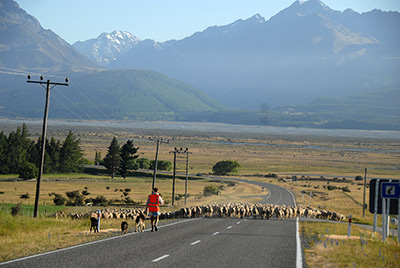 |
|
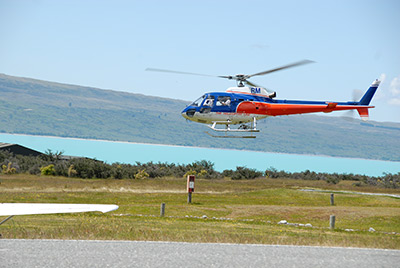 |
|
| |
Glentanner sheep |
|
Helicopter leaves for Cook tour |
|
| |
|
|
|
|
| |
Information about the Glentanner Park Centre, accommodations and guided activities is available at www.glentanner.co.nz. Developed in 1858, it has been owned by the Ivey family since 1957. The Iveys added heli-skiing in 1976 and opened the park centre in 1978 with budget housing and a campervan facility. Commercial offerings include horseback riding, helicopter and fixed wing aircraft flights, and Tasman Glacier kayak and boat trips. The sheep station has about 10,000 Merino sheep, 200 Hereford cattle and 230 red deer. Half the annual merino wool is sold at auction and half to manufacturers of merino wool products, including Icebreaker, SmartWool and Snow Peak. |
|
| |
|
|
| |
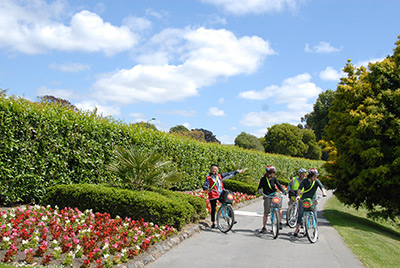 |
|
| |
Bicycle guide Sue |
|
| |
|
|
| |
Information about a variety of guided Christchurch bicycle rides on comfortable, retro-style bikes is available from www.chchbiketours.co.nz or chchbiketours@yahoo.co.nz.
During our two nights in Christchurch, the night after our arrival and the night before our departure, we stayed at the Sudima Hotel, only a short five to 10 minute walk from the airport. Shuttle service is available to and from the airport and buses easily connect with downtown Christchurch. The staff at the Sudima, which has dining facilities, proved extremely helpful in providing essential information. For information, and reservations are necessary during peak travel seasons, visit the Sudima website at www.sudimahotels.com.
The author
Lee Juillerat lives in Southern Oregon, where he is a writer-photographer for a daily newspaper. He is a frequent contributor to various magazines and publications, including Northwest Travel, Oregon Coast, Range, Capital Press and Horizon-Alaska in-flight magazines. He can be reached at lee337@cvc.net. |
|
| |
|
|
|
|
|


